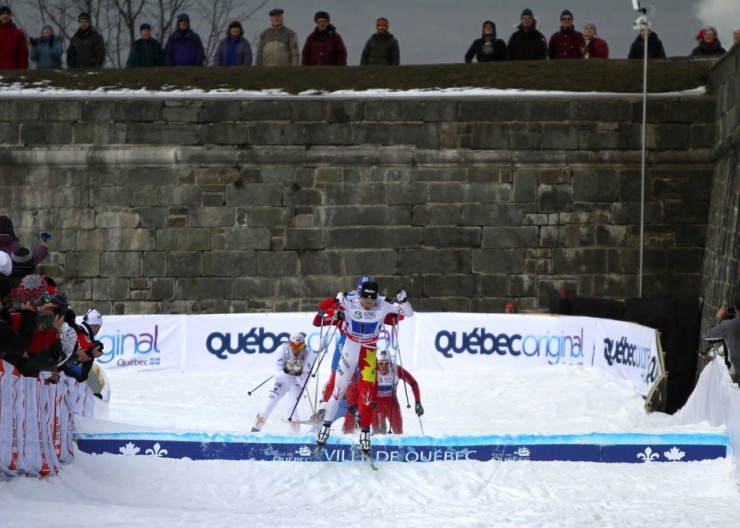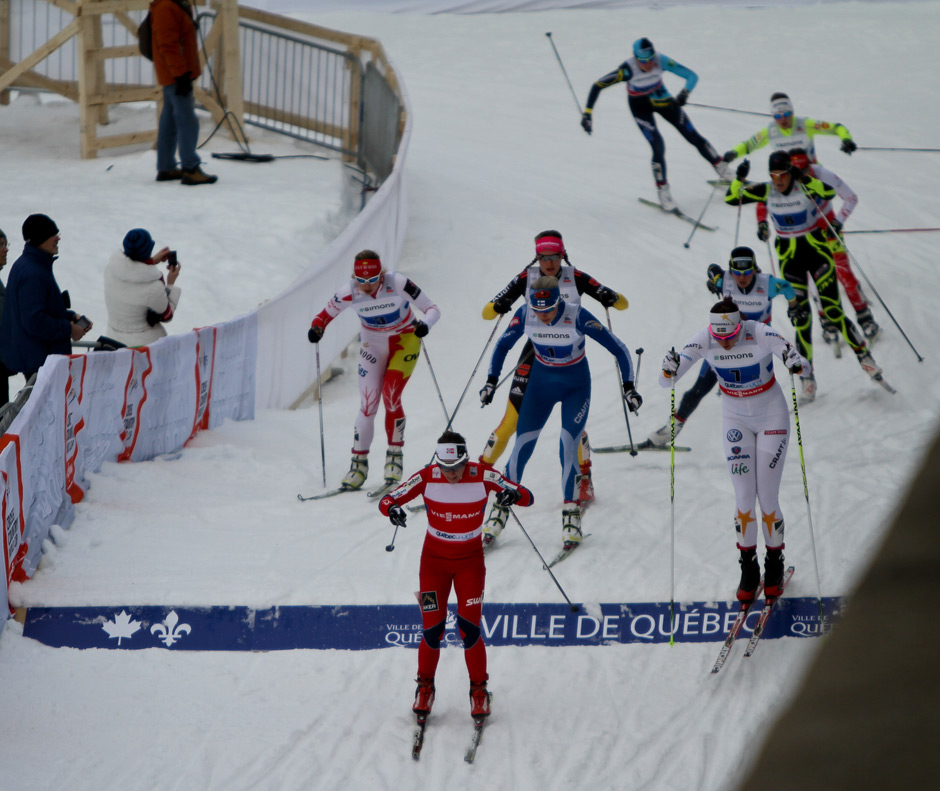
QUÉBEC CITY— It was an unprecedented stop, an unknown to everyone who raced there. Even the Canadians weren’t entirely sure what to expect in Québec City last weekend for the province’s first World Cup city sprints.
Nobody did. Spectators came out by the thousands. Gestev president and chief organizer Patrice Drouin estimated 50,000 people visited the venue in front of the Parliament building throughout the two days, with team sprints on Friday and individual sprints on Saturday.
That was a pretty good turnout considering there was little to no snow elsewhere in Québec in the weeks and days leading up to the event. Nearly 140 athletes from 17 nations showed up as well without knowing how competitive the sprints would be. (Top skiers like Marit Bjørgen, Therese Johaug, Petter Northug and Dario Cologna skipped the trip to Canada to prepare for the Tour de Ski.)

It didn’t really matter. There was enough else going on to keep people entertained and buzzing about the Québec World Cup.
For one, race organizers introduced a step down, or a jump, at the tail end of the 800-meter sprint course. It wasn’t huge, starting at a height of about 30 centimeters, but it did create enough space for a small “Ville de Québec” banner and a miniature ledge for racers to ski off.
The brainchild of Drouin, the step down was approved by the International Ski Federation (FIS) last spring to be used for the first time at the Québec World Cup. Coaches and racers had mixed oreactions – some said they didn’t see the point and others wanted it bigger – but in the end, few expressed strong feelings about it.
“It’s not a jump. It’s a bump,” said former Norwegian skier and Olympic champion Tor-Arne Hetland, a sprint coach for Switzerland.
“As long as it’s fair, then it’s good,” he added. “It shouldn’t be a problem, but it has to be well done.”
“It was too small. Bring us on a bigger one,” said Saturday’s individual sprint winner from Sweden, Emil Jönsson. “We don’t want to have a crash race. The strongest man should win, but it can be fun if we do it in a good way. Not a back flip, just a normal jump.”
The jump, bump, whatever you call it wasn’t really a game changer. A few athletes tumbled on or before it, but that generally happened when they were vying for position after the last downhill curve. Some people took more of an issue with the course’s curviness. Hetland suggested fewer curves and more straightaways, but said overall, “the track is good.”

Norwegian sprint coach Ulf Morten Aune was slightly more animated about the obstacle, calling it an unnecessary spectacle.
“There are enough curves and other stuff,” he said. “You do not have to do stuff like that. … This is not a circus, it is cross-country.”
From the standpoint of someone who’s designed mountain-bike courses, Drouin was curious whether it would work in cross-country. Twenty years ago, mountain bike races didn’t incorporate jumps, and now they do. He decided to give it a try and proposed the step down to FIS Cross-Country Race Director Pierre Mignerey, who ran it by homologation experts.
“They didn’t say no, so that means yes,” Mignerey said. He garnered the approval of FIS and gave Drouin the go-ahead.
“I know it’s a big deal because the fact that Pierre got out of that commission meeting and just gave me a big slap in the back and said, ‘Your jump is approved,’ I was surprised,” Drouin said. “I didn’t even think it was a case for a commission as technical as cross-country. Before changing things you have to get approval from the whole family.”
Drouin said FIS Cross-Country requirements were stricter than other world-class sporting events he’s organized (i.e. snowboarding and mountain biking), but he’d do it again without hesitation.
He created the step down knowing FIS inspectors might shoot down the final product and make him dismantle it before the races. It was ultimately OKed, but Drouin made a few alterations before the races started Friday.
“Everybody said, ‘If you can take this little uphill out, then we are fine,’ ” he said after hearing from athletes and coaches on Thursday. But the jump wasn’t finished yet; training wasn’t supposed to open until Friday morning so the feedback was based on a work in progress.
“The jump is was not an issue for us; it was not a deal breaker,” Drouin said. “It was just an additional thing to open up options.”
Mignerey said also it wasn’t a big deal, just a first step in something that could be used more in the future. The improvements made after Thursday quelled most people’s complaints, and Mignerey was open to seeing more of these jumps perhaps between 40 and 50 centimeters tall. “Why not?” he said, adding that it fits with city sprints.
At the same time, this doesn’t need to be something FIS standardizes, he added.
“We already have enough rules,” Mignerey said.
Some people just don’t understand it. Russia’s Gleb Retivykh said it would be better if Québec didn’t use one again “because it’s not interesting.”
“He don’t like it,” said Russian wax tech Urmas Vyalbe, who served as Retivykh’s translator. “He asked many times, ‘What is this? Why?’ ”
Norway’s Maiken Caspersen Falla, who placed third in Saturday’s individual sprint, said she hardly noticed it.
“I was thinking about it during the warmup, but in the race I just forgot about it,” she said. “I don’t see the point in cross-country skiing to have a jump, but if the crowd and the TV watchers like to see a jump, maybe we should have it.”
From a revenue point of view, it adds an attractive advertizing space for sponsors.
“It’s fun,” Slovenian head coach Marko Gracer said. “I think it’s also for the TV promotion.”
The Big Picture
Overall, participants’ reactions to Québec’s first World Cup were less divided. Gracer said it was well organized and perfect for a city sprint despite the challenges organizers faced in keeping the snow in tact.
Hard-packed conditions on Thursday deteriorated to a softer, sugar-like base by the end of Friday’s races. Temperatures above freezing made it difficult for groomers to change the snow structure, which left racers struggling to stay quick and upright in on Saturday.
“The snow was perfect Thursday and then it dried up when [they] packed the snow over again,” Hetland said. “There was not enough, it was getting soft … so that was too bad.”
Regardless, he said the course was fair and he’d like to see the World Cup return to Québec or at least Canada every year. Right now, the circuit visits North America every three years.
“I think it was absolutely something for the future and they should keep on doing this,” Hetland said. “When you get good skiers in Canada and America you should definitely every year have races here. Let’s make the cross-country family big. The World Cup opening should be in Canmore and here and then we should go home and then Tour de Ski.”
He added that Canada deserves to host the world’s best skiers at home. Having North American World Cups at the beginning of the season would eliminate the timing conflict for those preparing for the Tour de Ski in late December. On the other hand, snow is usually scarce or non-existent in most parts of the U.S. and Canada in November. Just 10 days before the Québec event, organizers were unable to make much snow. One option is to hold the races at the end of the season in March.
Norwegian Pål Golberg said earlier races in Canada would make adjusting to the time difference easier: once back in Europe, they’d be there for good.
“I think this works for those who aren’t skiing the Tour de Ski, but if we had this two weekends in November, I think there would be even more skiers here,” Golberg said.
In his first experience racing in North America, the 22-year-old would like to come back.
“The crowd is really enthusiastic and I think that’s maybe one of the most important things for the cross-country sport,” Golberg said.
“This is the best place, this town,” said Vyalbe, who was also visiting Québec for the first time. “When my friend called to me and asked, ‘Where are you?’ I said, ‘I am in Québec [pronounced Koo-bec].’ He said, ‘Ohh, the best place.’ ”
With the next stop in Canmore, Norway’s Øystein Pettersen said it’ll be hard to leave after the races Dec. 13-16.
“I love Canada,” Pettersen said. “Canada reminds me of Norway only everything is a lot bigger, people are a lot more open-minded. In Norway we like to focus on ourself and don’t talk, don’t smile. In Canada everybody’s happy.”
— Nat Herz and Topher Sabot contributed reporting
Alex Kochon
Alex Kochon (alexkochon@gmail.com) is a former FasterSkier editor and roving reporter who never really lost touch with the nordic scene. A freelance writer, editor, and outdoor-loving mom of two, she lives in northeastern New York and enjoys adventuring in the Adirondacks. She shares her passion for sports and recreation as the co-founder of "Ride On! Mountain Bike Trail Guide" and a sales and content contributor at Curated.com. When she's not skiing or chasing her kids around, Alex assists authors as a production and marketing coordinator for iPub Global Connection.



